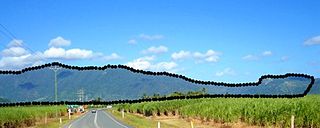
Australian Aboriginal religion and mythology is the sacred spirituality represented in the stories performed by Aboriginal Australians within each of the language groups across Australia in their ceremonies. Aboriginal spirituality includes the Dreamtime, songlines, and Aboriginal oral literature.
Mana is the spiritual life force energy or healing power that permeates the universe, in the culture of the Melanesians and Polynesians. Anyone or thing can have Mana. It is a cultivation or possession of energy and power, rather than being a source of power. It is an intentional force.
The Alyawarre, also spelt Alyawarr and also known as the Iliaura, are an Aboriginal Australian people, or language group, from the Northern Territory. The Alyawarre are made up of roughly 1,200 associated peoples and actively engage in local traditions such as awelye painting.
The Pintupi are an Australian Aboriginal group who are part of the Western Desert cultural group and whose traditional land is in the area west of Lake Macdonald and Lake Mackay in Western Australia. These people moved into the Aboriginal communities of Papunya and Haasts Bluff in the west of the Northern Territory in the 1940s–1980s. The last Pintupi to leave their traditional lifestyle in the desert, in 1984, are a group known as the Pintupi Nine, also sometimes called the "lost tribe".

The Ngarinyin language, also known as Ungarinjin and Eastern Worrorran, is a moribund Australian Aboriginal language of Western Australia spoken by the Ngarinyin people.
Melpa is a Papuan language spoken by about 130,000 people predominantly in Mount Hagen and the surrounding district of Western Highlands Province, Papua New Guinea.

Myth and ritual are two central components of religious practice. Although myth and ritual are commonly united as parts of religion, the exact relationship between them has been a matter of controversy among scholars. One of the approaches to this problem is "the myth and ritual, or myth-ritualist, theory," held notably by the so-called Cambridge Ritualists, which holds that "myth does not stand by itself but is tied to ritual." This theory is still disputed; many scholars now believe that myth and ritual share common paradigms, but not that one developed from the other.

Catherine Helen Berndt, néeWebb, born in Auckland, was an Australian anthropologist known for her research in Australia and Papua New Guinea. She was awarded in 1950 the Percy Smith Medal from the University of Otago, New Zealand and in 1980 she received a children's book award and medal for her book, Land of the Rainbow Snake, a collection of stories from Western Arnhem Land.
The Bantu beliefs are the system of beliefs and legends of the Bantu people of Africa. Although Bantu peoples account for several hundred different ethnic groups, there is a high degree of homogeneity in Bantu cultures and customs, just as in Bantu languages. The phrase "Bantu mythology" usually refers to the common, recurring themes that are found in all or most Bantu cultures.
Wadjiginy, also known as Wagaydy (Wogait) and Batjamalh, is an Australian Aboriginal language. Apart from being closely related to Kandjerramalh, it is not known to be related to any other language, though it has borrowed grammatical and lexical material from neighboring Northern Daly languages.
The Nyangumarta people, also written Njaŋumada, Njangamada, Njanjamarta and other variations, are a nation of Aboriginal Australians from the northwestern coast of Western Australia. According to Norman Tindale, they are divided into two distinct branches, the Kundal and the Iparuka.

The Bunuba are a group of Indigenous Australians and are one of the traditional owners of the southern West Kimberley, in Western Australia. Many now live in and around the town of Fitzroy Crossing.
The Kaantyu are an Indigenous Australian people of the Cape York Peninsula. They live in the area around the present day town of Coen. Most of their traditional tribal land has been taken over for cattle stations. Kaantju refers to the hook of the yuli, their word for woomera.
The Mati Ke, also known as the Magatige, are an Aboriginal Australian people, whose traditional lands are located in the Wadeye area in the Northern Territory. Their language is in danger of extinction, but there is a language revival project under way to preserve it.
The Night Island Kawadji, or Uutaalnganu, were an Indigenous Australian group of Cape York Peninsula in northern Queensland. The name is also used collectively for several tribes in this area, such as the Pontunj / Jangkonj (Yanganyu), whose language is unconfirmed.
The Maringar are an indigenous Australian people of the Northern Territory.
The Ngundjan (Ogh-Undjan) were an indigenous Australian people of the state of Queensland.
The Kokomini (Gugumini) are reported to have been an indigenous Australian people of the state of Queensland, though some indications suggest the term may refer to a loose confederation of tribal groups.
The Wambaya are an indigenous Australian people of the Northern Territory.
The Mudburra, also spelt Mudbara and other variants, are an Aboriginal Australian people of the Northern Territory.




